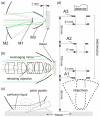Hybrid reflecting objectives for functional multiphoton microscopy in turbid media
- PMID: 16880851
- PMCID: PMC2916932
- DOI: 10.1364/ol.31.002447
Hybrid reflecting objectives for functional multiphoton microscopy in turbid media
Abstract
Most multiphoton imaging of biological specimens is performed using microscope objectives optimized for high image quality under wide-field illumination. We present a class of objectives designed de novo without regard for these traditional constraints, driven exclusively by the needs of fast multiphoton imaging in turbid media: the delivery of femtosecond pulses without dispersion and the efficient collection of fluorescence. We model the performance of one such design optimized for a typical brain-imaging setup and show that it can greatly outperform objectives commonly used for this task.
Figures



Similar articles
-
Effect of excitation wavelength on penetration depth in nonlinear optical microscopy of turbid media.J Biomed Opt. 2009 Jan-Feb;14(1):010508. doi: 10.1117/1.3081544. J Biomed Opt. 2009. PMID: 19256688 Free PMC article.
-
Adaptive optics improves multiphoton super-resolution imaging.Nat Methods. 2017 Sep;14(9):869-872. doi: 10.1038/nmeth.4337. Epub 2017 Jun 19. Nat Methods. 2017. PMID: 28628128 Free PMC article.
-
Multispot point spread function for multiphoton fluorescence microscopy.Rev Sci Instrum. 2009 Sep;80(9):096104. doi: 10.1063/1.3226658. Rev Sci Instrum. 2009. PMID: 19791975
-
[Nonlinear Microscopy in Ophthalmology: Principles and Pathbreaking Applications].Klin Monbl Augenheilkd. 2015 Dec;232(12):1365-73. doi: 10.1055/s-0041-109020. Epub 2015 Dec 17. Klin Monbl Augenheilkd. 2015. PMID: 26678898 Review. German.
-
Nonlinear magic: multiphoton microscopy in the biosciences.Nat Biotechnol. 2003 Nov;21(11):1369-77. doi: 10.1038/nbt899. Nat Biotechnol. 2003. PMID: 14595365 Review.
Cited by
-
A multiphoton objective design with incorporated beam splitter for enhanced fluorescence collection.Opt Express. 2010 Mar 15;18(6):5390-8. doi: 10.1364/OE.18.005390. Opt Express. 2010. PMID: 20389554 Free PMC article.
-
Optical constraints on two-photon voltage imaging.Neurophotonics. 2024 Jul;11(3):035007. doi: 10.1117/1.NPh.11.3.035007. Epub 2024 Aug 13. Neurophotonics. 2024. PMID: 39139631 Free PMC article.
-
Compact non-contact total emission detection for in vivo multiphoton excitation microscopy.J Microsc. 2014 Feb;253(2):83-92. doi: 10.1111/jmi.12099. Epub 2013 Nov 19. J Microsc. 2014. PMID: 24251437 Free PMC article.
-
Comparison of objective lenses for multiphoton microscopy in turbid samples.Biomed Opt Express. 2015 Jul 30;6(8):3113-27. doi: 10.1364/BOE.6.003113. eCollection 2015 Aug 1. Biomed Opt Express. 2015. PMID: 26309771 Free PMC article.
-
Rational optimization and imaging in vivo of a genetically encoded optical voltage reporter.J Neurosci. 2008 May 21;28(21):5582-93. doi: 10.1523/JNEUROSCI.0055-08.2008. J Neurosci. 2008. PMID: 18495892 Free PMC article.
References
-
- Denk W, Strickler JH, Webb WW. Science. 1990;248:73. - PubMed
-
- Helmchen F, Denk W. Nat. Methods. 2005;2:932. - PubMed
-
- Oheim M, Beaurepaire E, Chaigneau E, Mertz J, Charpak S. J. Neurosci. Methods. 2001;111:29. - PubMed
-
- Beaurepaire E, Mertz J. Appl. Opt. 2002;41:5376. - PubMed
-
- Taddeucci A, Martelli F, Barilli M, Ferrari M, Zaccanti G. J. Biomed. Opt. 1996;1:117. - PubMed
Publication types
MeSH terms
Grants and funding
LinkOut - more resources
Full Text Sources

